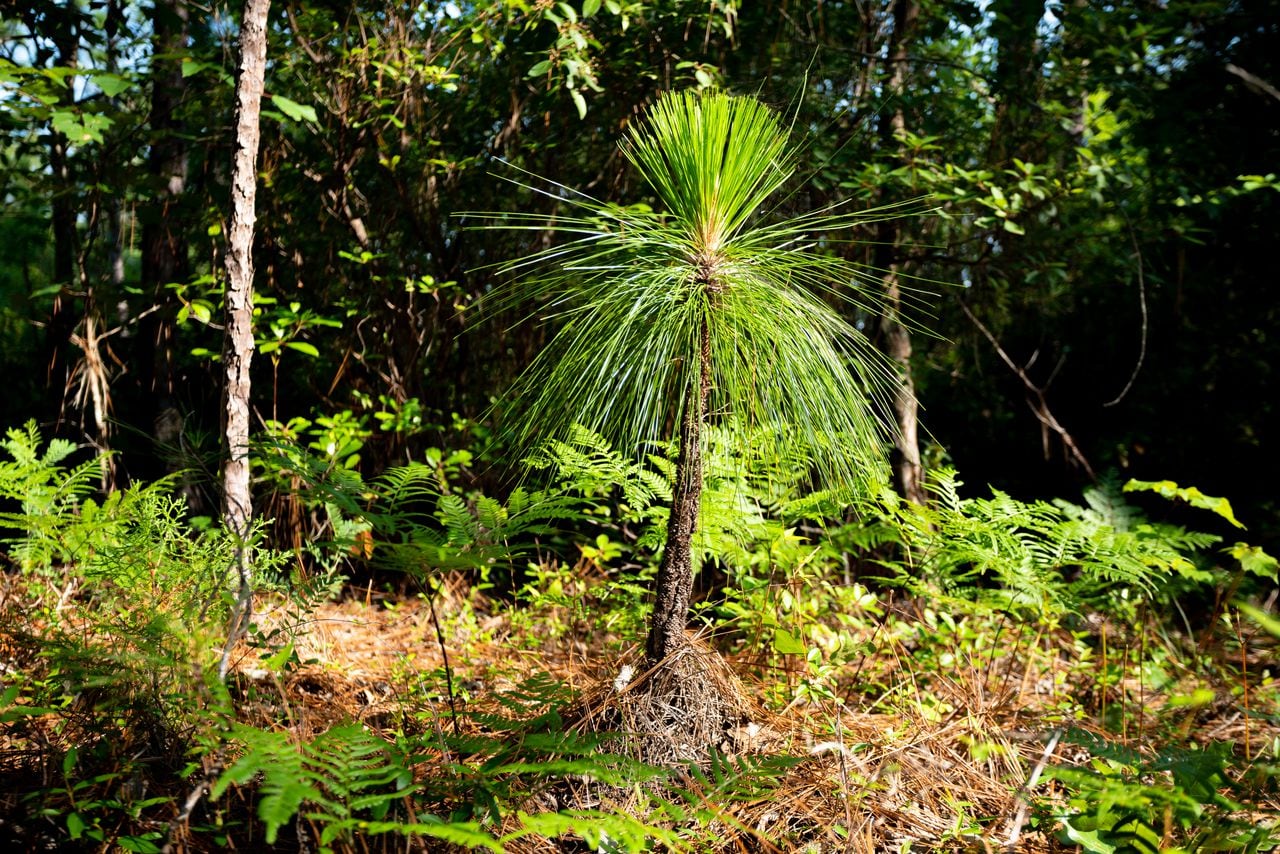Longleaf restoration falls short, even as it gains support as a climate solution
The massive public-private effort to bring back the South’s most iconic tree—the longleaf pine—is falling short of its original restoration goal.
The drive to revive the longleaf pine—the state tree of Alabama—is occurring across a nine-state region that is losing forest faster than any other part of the country. But the restoration isn’t moving as fast as hoped.
The partnership, America’s Longleaf Restoration Initiative, last month released a new plan that gives itself 15 more years to get 8 million acres of longleaf in place, a target the group had hoped to meet by 2025.
Bringing back the pine that dominated Alabama’s landscape in the past is an important move to gird the state for the future, experts say. The state’s vast forests have been stocked for decades with fast-growing trees like loblolly and slash pines that historically were a small portion of Alabama’s terrain. These easy-maintenance trees are great for churning out pulp and paper, but weak against the increasing assaults of disease, wind and drought in a time of climate change..
Longleaf is slower growing and requires intensive management in the modern landscape,but it is resistant to pine beetles, withstands hurricanes better than other pines and slows down its uptake of water when rain is scarce. To promote longleaf, forest managers need to set regular, low-intensity fires and thin out other trees to clear out competing vegetation. By doing so, they reduce the risk of catastrophic wildfire.
Moreover, longleaf restoration recreates a native ecosystem of mixed grasses and wildflowers in which the most iconic wildlife of the South can thrive. It means reviving the habitat of the red-cockaded woodpecker, eastern indigo snake, the gopher tortoise and scores of other species that have become endangered or threatened due to longleaf’s demise.
Restoration won’t bring back forest lost to urban and suburban development, but would replace existing forest—including the weaker loblolly and slash pine—to make way for the longleaf.
Inside Climate News and AL.com spent five months examining the many trade-offs, and found:
- Since 2009, the coalition has achieved a 30 percent increase in the amount of longleaf on the landscape to about 5.2 million acres. But that’s just 6 percent of the 92 million acres of longleaf forest that once covered the Southeast.
- At least $700 million has been spent since 2010 on longleaf restoration by three federal agencies, nine states, numerous nonprofit groups and array of corporations involved. Federal government spending is spread out through an array of farm, forest, land and wildlife conservation programs, and is not easily tracked.
- The financial support has been crucial to private landowners, who hold 87 percent of the Southern forest, and forgo faster returns to grow longleaf.
- Although longleaf stores more carbon and is more resilient than other pines, it will be years until newly planted stands realize their promise as a climate solution. Meanwhile, restoration generates carbon emissions, not only due to repeated prescribed burning required, but also because older trees are cut down to make way for young longleaf.
- The fast-growing wood pellet industry, Enviva and Drax, which have been expanding operations in Alabama, are major participants in longleaf restoration. They get a reputational boost at a time when their biggest customers in Europe are questioning the sustainability of their operations, and they gain access to new raw material—the lower value trees removed in favor of longleaf.
- On National Forests, which cover a small part of the Southeast but hold an outsized share of existing longleaf, timber sales can get in the way of restoration. To allow for sale of nearby stands and logging, the Forest Service sometimes defers prescribed burns as long as 10 years—the upper limit of the recommended interval between burns.
- Although the longleaf partners see their effort in sync with President Joe Biden’s goal of managing U.S. forests for greater climate resilience, the widespread harvests clash with Biden’s stated objective of protecting mature forests as carbon sinks. In one planned 5,000-acre logging and clearcutting project in Talladega National Forest in Alabama, 70 percent of the targeted stands are more than 61 years old.
- Climate change is making longleaf restoration more difficult—substantially reducing the number of summer days in the South when prescribed burning is feasible and safe. Forest managers are shifting burns to winter months, when they are less effective. One survey shows 38 percent of longleaf forest managers report that they do not burn as often as they should, due to weather, lack of equipment, funding or personnel.
The findings suggest that the front end of the restoration effort—cutting down trees—is far easier to implement than growing and maintaining healthy longleaf forest. With the partnership aiming to accelerate and improve its efforts, longleaf restoration is shaping up to be a major test of nature-based climate solutions in a landscape that already is being transformed by global warming, as well as human development and economic pressure.
